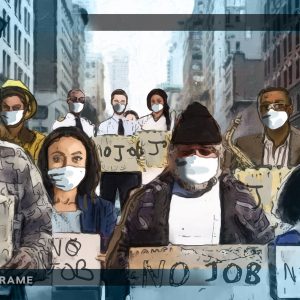Why South Africa needs a universal basic income grant
The SA government’s embrace of the household grant is a move to forestall a universal basic income grant. But this will do little for the economy and poverty alleviation.
Author:
4 November 2021

There has been a furious response from several research and lobbying organisations to rumours of a reform of the welfare system in South Africa. Apparently, the South African government is considering a local version of the Bolsa Familia, the Brazilian family grant introduced to much fanfare in 2003. The Black Sash, the Institute for Economic Justice, the Studies in Poverty and Inequality Institute (SPII), #PayTheGrants and Amandla have protested that such an intervention is likely unconstitutional, is anti-poor and is in any case unfeasible.
Something other than doubts about the workability or fairness of the scheme is at play here, however. The real worry is that a household grant will be used as a substitute for a Universal Basic Income Grant (UBIG). The purpose of reform, that is, is negative: to stall current momentum in favour of a UBIG.
To mitigate the spread of the Covid-19 virus, President Cyril Ramaphosa announced a nationwide shutdown in March 2020. The economic results were devastating as millions of South Africans found themselves with either reduced incomes or no incomes at all, adding to the millions of people already unemployed. In response to advocacy, the government began designing a welfare response. Several options were on the table, including an expansion of the existing Child Support Grant (CSG). Economic modelling, however, suggested that the CSG route was unlikely to reach those whom Covid-19 left most vulnerable: unemployed men without access to social protection. In the technical language of economists, this meant that the CSG was not very efficient. A Social Relief of Distress (SRD) grant was rolled out instead. For the first time ever in South Africa those people not eligible for existing forms of social protection (largely unemployed men) received temporary support. By all accounts the SRD was a huge success.
Related article:
For many advocates of welfare reform, the SRD seemed to gesture to an important shift in government thinking. It looked like a step in the direction of a UBIG for South Africa. There had been previous moves in this direction. In 2002, the government-appointed Taylor committee proposed reforming the welfare system in South Africa in the direction of a UBIG. The proposal was strongly supported by the Democratic Alliance, but not the ANC. Ultimately, nothing came of the recommendations.
The ANC’s approach to welfare was that it was an interim measure for people temporarily not in employment. Incredibly, the economy was assumed to be fast-growing and labour-absorbing across employment types and skills levels. Unemployed persons receive protection only in the form of a temporary insurance benefit. Social protection only extends to those who are financially vulnerable and who care for children. In the main, women are regarded as child carers and it is largely women who are beneficiaries of social grants. In this way, social protection instruments in South Africa leave unemployed men exposed. Even under the most optimistic of scenarios, a substantial part of the working-age population will not be integrated in the formal labour market.
As several authors have noted, the current model of welfare underestimates unemployment as a mass, structural phenomenon of the South African economy. Wage labour can no longer serve as the main basis for social membership.
Making a case for the UBIG
Let us leave aside claims that support for a household grant represents bad faith on the side of the National Treasury. There is enough information in the public domain to reconstruct the arguments that might inform current opposition to a UBIG in South Africa. It is to these that we turn. We do not believe that they are robust.
The arguments can be summarised as: one, a moral argument; two, an argument about efficiency; three, an argument about effectiveness and, four, an argument about affordability.
The first argument reproduces an age-old prejudice about the impoverished, given a gendered inflection in South Africa. What troubles many policy makers about an unconditional grant is that impoverished people will spend the money recklessly, on booze, or they will get further into debt and so on. In South Africa, impoverished Black men are deemed an especially toxic demographic, so that handing money over to them each month is thought to be a recipe for wastefulness. It seems that what is lurking behind this assumption is nostalgia for the policing, paternalism and surveillance of the traditional welfare state. In fact, provisional analysis of the SRD grant, which was taken up largely by men, unsettles these clichés.
Related article:
The second argument is about the efficiency of the UBIG relative to others. It is not clear what measure of efficiency the National Treasury is using. But if the intention is to reduce poverty, then economists have a test. Assuming that government capacity to administer the grant is the same for all types (we will come to this) they ask how much of each rand spent targets the impoverished? Recent analysis by the Southern African Labour and Development Research Unit (SALDRU) at the University of Cape Town, comprising many of South Africa’s leading economists, found that the Child Support Grant was relatively efficient. The UBIG was apparently the least efficient of the grants. The most efficient, according to SALDRU, is the Household Grant. The SALDRU analysis has apparently been influential in National Treasury circles.
The UBIG is by definition inefficient on these terms. It is a universal grant whose beneficiaries include everyone, both the impoverished and those who are not impoverished. In the South African context this is not a weakness but potentially a massive benefit. The UBIG should not be viewed as a grant, but as the citizen’s income that, according to James Ferguson, acknowledges a kind of nationwide membership and solidarity that would go beyond such political rituals as voting to include rights to subsistence and consumption.
Related article:
It also potentially provides a solution to one of South Africa’s most serious social problems: the lack of social solidarity (what the government calls social cohesion) across races, between classes and between people of different genders. If middle-class recipients chose not to claim their grants or donated their grants to civil-society bodies, the UBIG could be the basis of a new solidarity economy. The effects would be transformational. Universal options also involve designs where the allocations to higher-income groups are taxed back through slight increments to tax rates. This targets the low-earning and jobless adults without the need for administratively inefficient means-tests.
The third argument is the easiest to understand. The UBIG is hands down the easiest to administer. It does not require large and complex administrations to target beneficiaries or to administer means tests. The UBIG could be accessed by any citizen at any automatic cash dispenser and in that way it successfully avoids the patronage and potential corruption associated with traditional handouts. This is surely a decisive consideration in the face of government administrations seriously weakened and compromised after years of “state capture”. Also, its universal nature means that no additional costs have to be imposed on the impoverished to prove their status in order to access their right.
The issue of cost
It is likely, however, that in government-policy circles the UBIG really falls on the basis of cost, or more accurately opportunity costs. The SALDRU analysis estimates that it would cost the fiscus R206.4 billion a year. In contrast, the household grant would be less than a third of that expense at R58.7 billion per year.
| Policy option | Average value | Total beneficiaries (millions) |
Annual cost | |
| Direct | Indirect | (R, billion) | ||
| CSG (increased grant size) | 164 | 7.0 | 30.0 | 27.7 |
| SRD with FPL threshold | 350 | 16.8 | 43.0 | 70.9 |
| BIG (clawback) | 597 | 28.8 | 54.3 | 206.4 |
| FPG variable benefit | 1,001 | 4.9 | 19.8 | 58.7 |
| Public works (NMW) at 2m | 1446 | 2.0 | 8.5 | 34.6 |
Source: SALDRU, 2021
It is not so much that the money is not available in absolute terms. Rather, the assumption here is that expanding welfare comes at the expense of economic growth. There is evidence to support this argument. In South Africa, welfare spending and spending on the salaries of public servants as well as local government officials has traditionally crowded out capital spending on infrastructure. Therein lay the promise of the Zuma administration; that this legacy would be reversed. The appalling consequence of state capture is that the investment in economic goods (trains, ports, power stations) was largely stolen or mismanaged. There have been no benefits, only burdens, from the hundreds of billions of rand spent on “infrastructure” after 2009.
The poor state of economic infrastructure is testimony to the venality of South Africa’s political class. It is also, however, an effect of mass unemployment and poverty. Every day, in thousands of separate acts, South Africa’s infrastructure is stolen. Copper wires, road-side balustrades, electrical switches in robots, rail-tracks and entire railway stations are carried away by ordinary people struggling for a livelihood. Welfare support might be the most efficient means of safeguarding South Africa’s current infrastructure.
Even if there was growth it is far from clear that the South African government has the capacity to direct it towards sectors or activities that are labour absorbing. A more consistent analysis suggests that unemployment in South Africa is massive and structural. Growth will produce jobs for only certain categories of people (urban, highly skilled), leaving the vast majority dependent on welfare or the informal economy or both. In this situation, planning for economic growth requires planning for welfare at the same time.
Related podcast:
In this context, a UBIG is the most appropriate measure, not simply because it is right or just, but because it responds more precisely to the nature of the South African economy as it really is.
Even if implementing the UBIG was determined too risky in the short- to medium-term, the question is whether the pathway should be deliberately blocked by plainly inferior policies, the only rationale for which is to crowd out the opportunities for wider support for jobless and low-earning adults in South Africa.
Ivor Chipkin and Jelena Vidojevic are researchers at the think tank Government and Public Policy (GAPP). See ‘The gendered character of welfare: Reconsidering vulnerability and violence in South Africa’, Social Dynamics 47(3).
Alex van den Heever holds the Chair in Social Security Systems, Administration and Management Studies at the Wits School of Governance.




